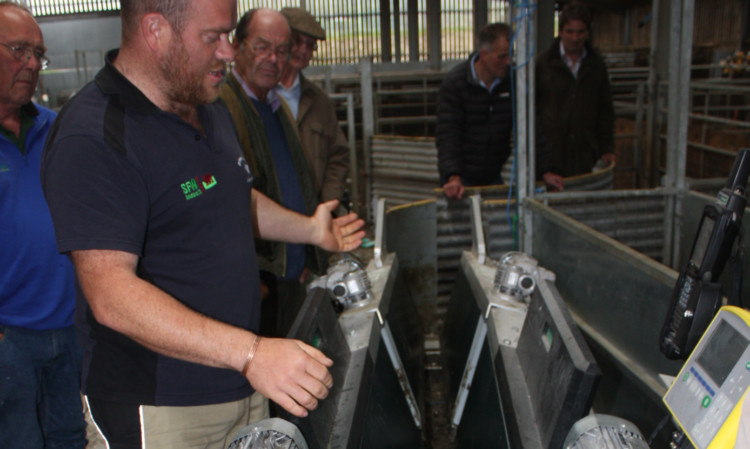careful stock selection, advantageous use of electronic identification, and top-class grassland management has helped Pembrokeshire farmer Neil Perkins become one of the UK’s most efficient sheep farmers.
He, his wife Lynda and father Roger farm 600 acres at Dinas Island near Newport, Wales.
Most of the land is rented from the National Trust with some owner-occupied.
Despite its name most of the farm is on a peninsula which rises gently from the farm buildings towards sea cliffs which form part of the Pembrokeshire coastal path.
Lynda and her father-in-law make the most of the location by letting out six holiday cottages and running a camp site.
“I am no use at that because I am far too rude to deal with the public,” Neil told a visiting group from the Edinburgh Agricultural Society.
He concentrates instead entirely on the sheep enterprise which now runs to 1,800 Lleyn ewes and 400 followers.
The turning point for the Perkins family came with two consecutive scholarships.
In 2001 a Churchill Scholarship saw Roger heading for New Zealand to study livestock production and four years later Neil followed in his footsteps courtesy of a Nuffield Scholarship.
The result was an end to a mixed enterprise which had encompassed pigs, beef, sheep and arable and a decision to concentrate on sheep using a one-breed policy and maximising grass production.
Previously the Perkins family had bought Welsh Speckled Faced ewes and crossedthem with a Bluefaced Leicester to produce ewes capable of being crossed with a terminal sire.
The decision was made instead to focus entirely on the Lleyn breed and carefully build up genetic merit within the flock.
Neil runs a three-flock system with Flock A comprising the best performing ewes bred pure with high-merit pure Lleyn rams.
“I now have 250 ewes in this flock and they have everything that we want they are perfect ewes,” he said.
“Eventually I would like to have 400 in this flock.”
This elite flock provides replacements which cascade down into Flock B which is mostly crossed with a New Zealand Texel.
This flock in turn provides replacements for Flock C which only produces slaughter lambs.
The speed at which individual animals move down through the flocks depends on analysis of recorded data.
For example, Neil had noticed he had around 250 cases of lameness annually but that this included some ewes which had been treated up to 10 times.
Anything showing problems is immediately demoted to the Flock C and no daughters retained for breeding.
This might sound horrendously complicated to manage but Neil has embraced all the latest technology to make it quite simple.
An early enthusiast for EID, he now combines this with a DM Handling Systems race with built in tag readers.
Made by David McGillvray on his farm near Falkirk, the machine consists of twin conveyor belts set in a V formation.
As the sheep enters the race it is gently picked up and held as it is carried forward over weigh cells and past tag readers mounted on either side of the chassis.
The machine is constantly in use for tasks such as vaccinating and dosing but its key function is to separate the A, B and C flocks prior to tupping.
Apart from that short period the flocks are not kept separate and are treated exactly the same.
“In fact once we see them separated Flock A doesn’t always look the best but that is because the ewes have been working harder rearing really good lambs,” said Neil.
He readily admits the system would never work without EID because of the amount of data involved.
Now it is simply a case of programming the DM machine to allow its shedding gates to automatically do the work.
Grassland management benefits from the same level of detailed management.
High-sugar grasses are mixed with clovers and chicory with leys expected to last up to 10 years.
Using a quad bike-mounted device growth is measured weekly, allowing a detailed grazing programme to be worked out and surplus paddocks diverted into silage.
At this time of year Neil expects his leys to produce around 75 kilograms of dry matter per hectare per day and a lamb to consume around 900 grams.
“We fertilise the paddocks to maintain production,” Neil said.
“In this system it is very important never to run out of grass.”
Despite its coastal location and mild climate the soils are deemed too heavy for outwintering and the ewes spend the two months up to the March lambing period indoors.
A recently constructed 60 metre by 30 metre lambing shed has made life much easier.
All lambs are weighed every four weeks and wormed as required with the aim being to have the whole crop finished off grass.
